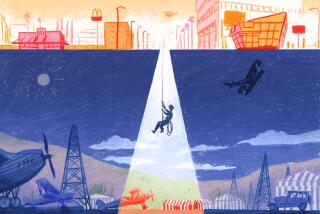The Cattle Baron and the Curse
He was an entrepreneur blessed with vast amounts of land, but with that blessing came a curse.
Ultimately, cattle baron Walter L. Vail--who owned hundreds of thousands of acres from Arizona to Santa Rosa Island, and leased many more--would lend his name to a fledgling airport in what is now Commerce.
His fortune was founded on all that land--and, perhaps, so was his undoing. The problem didn’t arise from property Vail owned, but from a parcel he leased--a tract cursed by a bitter Native American on the morning he was exiled from it.
In 1888, Vail and a partner began expanding their Arizona cattle empire by leasing about 30,000 acres in San Diego County.
Besides its fertile cattle pastures, the land--called Warner Hot Springs--was home to 100 Cupeno Indians, who in 1903 were forced by the landholders onto the Pala Indian Reservation to the west.
Before they embarked on what would be called their “trail of tears,” one of the tribe’s leaders, Captain Cibemont, issued a curse. He stamped his foot three times and spat the traditional three times on the ground. He promptly informed the white landholders that their lives would be ruined and that they could eat sand from that day on.
Three years later, Vail’s life would be cut short, at age 54, when a streetcar ran over him in downtown Los Angeles.
Not long after the accident, Warner Hot Springs officials begged the Cupeno Indians to return briefly to remove the curse, which they did.
Perhaps because of that favor, Vail’s survivors prospered, became well-known in ranching circles and made even bigger names for themselves when an airfield was named in their honor.
In 1890, before the family patriarch died, he and a partner bought 1,000 acres of Rancho Laguna, about five miles southeast of Los Angeles. It was there that Vail and his descendants would raise cattle, explore for oil, develop a water system to promote a subdivision and ultimately lease part of the land for an airfield.
But it was the arrival of the nation’s first air carrier, Western Air Express, that ushered Vail Field into aviation history.
On April 17, 1926, when it was little more than a dusty airstrip in a grain field, about 1,000 people gathered to witness the first scheduled commercial airline flight--carrying mail in this case--from Salt Lake City to Los Angeles. The flight took slightly more than seven hours.
As the open-cockpit, single-engine Douglas M-2 landed, a cheer went up and people threw their hats into the air. Western Air Express--the forerunner of Western Airlines--was born.
The company, whose four pilots were called the Four Horsemen, moved into its new headquarters on the property, an abandoned metal shed that had once enclosed a silent film stage on Telegraph Road near Garfield and Yates avenues.
The next month, before the airline began officially shuttling passengers, humorist Will Rogers wanted to fly from Los Angeles to Las Vegas, where the Salt Lake-bound plane stopped for fueling only. So he bought enough stamps to mail all 180 pounds of himself, and made the trip as “airmail.”
Rogers’ antics opened the door for passenger service, which began May 23, 1926, on folding chairs set on the plane’s floor. The pilots laughingly quoted the flight schedules as “GWWP”--God Willing, Weather Permitting.
As the seating improved, Western Air Express called itself the “Model Airway” and sent limousines to pick up illustrious passengers, including movie star Mary Pickford.
On Sept. 20, 1927, tens of thousands of spectators turned out for the arrival of Charles Lindbergh and the Spirit of St. Louis on his nationwide tour after his solo transatlantic flight that May.
When Lindbergh was asked his impression of Vail Field, The Times reported that “the world’s premier flyer termed it ‘good. Better than the average landing field, especially in its length.’ ”
His remark wouldn’t win Vail Field any awards, but in another decade--with its relatively fog-free weather conditions--it would be one of the sites considered for the Los Angeles Municipal Airport.
But it was fogbound Mines Airport, the forerunner of LAX, that won the final decision.
In 1952, five years after the Vail family sold the land, Vail Field disappeared under an extension of Washington Boulevard.
More to Read
Sign up for Essential California
The most important California stories and recommendations in your inbox every morning.
You may occasionally receive promotional content from the Los Angeles Times.










